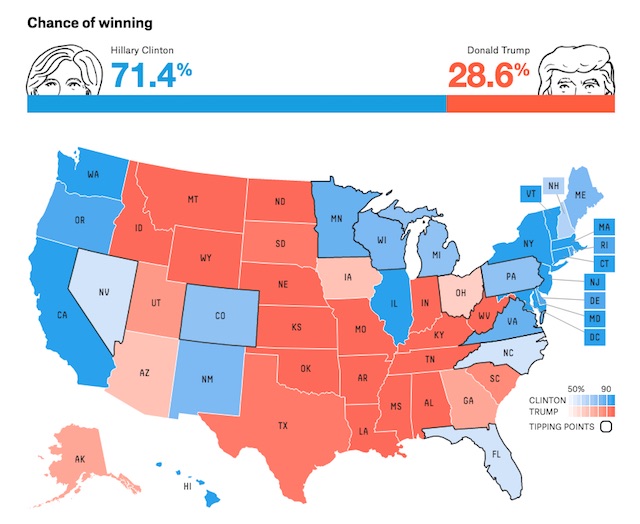Nate Silver wasn’t wrong

My Facebook feed is full of people angry at election forecaster Nate Silver of fivethirtyeight.com, declaring him a failure. They’re wrong. Here’s why he was right . . . and why you’re blaming the wrong guy.
My argument has three simple points:
- Nate Silver’s forecast wasn’t wrong, because he didn’t predict a Clinton win.
- Polling error and undecideds kept Trump in the race, just as Silver had warned us they might.
- The pollsters and forecasters didn’t create this result, the candidates and the electorate did.
(To be clear, Silver had earlier predicted that Trump would not win the Republican nomination, and he was wrong about that. But that wasn’t a model-based prediction. The election night prediction was, and it wasn’t wrong.)
Nate Silver’s forecast wasn’t wrong
Fivethirtyeight — the most popular election prediction site — predicted on Tuesday morning that there was a 71.4% chance that Clinton would win, and a 28.6% chance that Trump would. The site’s leader, Nate Silver, stood by his prediction despite withering criticism from those who felt Clinton was a lock. Other sites gave Clinton far better chances: The New York Times’ “Upshot” rated Clinton a 90% favorite.
The problem here is that although 71.4% is not certainty, it sure felt like it. Our minds have trouble with probabilities. They rounds things up.
Think about it this way.
If there was a 29% chance of rain, would you bring an umbrella?
If you were about to step into a crosswalk and there was a 29% chance of getting hit by a car, would you cross against the light?
A lot of us were checking the site repeatedly leading up to the election. Trump’s odds had decreased from 35% or so to 29%. This made Clinton backers feel better. But while 29% is smaller than 35%, it is a long way from zero, and we should have understood that.
Nate Silver knew there was a much higher degree of uncertainty than there had been in 2012, and said so. People who deal regularly with statistics know that uncertainty is a real thing — that it quantifies how likely it is that you could be wrong. Ignoring the uncertainty is a mistake. It sure was on Tuesday.
(Incidentally, his final forecast rated the race for control of the Senate at about 50-50 — so no one should have been surprised that the Senate stayed Republican.)
Polling error and undecideds kept Trump in the race
Here are the reasons — stated ahead of the vote — that fivethirtyeight maintained higher chances for Trump than his competitors:
- There was a measurable and significant chance that all the polls could could have a systematic error in the same direction.
- Before election day, there were an unusually large number of undecided and third-party voters, and they could end up voting for Trump.
Both of these factors ended up being relevant.
First, the polling error. Polls have one fundamental flaw: you cannot poll someone who chooses not to answer the poll. This creates nonresponse bias, and there is no way to correct for it. If non-respondents favor one candidate over another, pollsters will miss it. Such an error is systematic — it affects all the polls, national and in all states, in the same direction.
In this case, there’s some evidence that white women without college degrees favored Trump more than the polls indicated. The white women in the polls favored Clinton more than the ones who didn’t answer, and that fooled the pollsters.
The polling error was not huge. The final polling average favored Clinton by 3% nationwide. In the final popular vote, Clinton won by 1%. This 2% polling error was within the range that Silver expected, which is why he maintained a higher winning percentage for Trump than other forecasters. The white women without degrees in Pennsylvania, Wisconsin, and Michigan pushed those states into the Trump column — a result that the polls missed.
The second factor is the undecided and third-party voters. Late polls showed about 8% undecided and 7% third-party voters — 15% of the electorate choosing neither Trump nor Clinton. In the end, 5% of the votes went to third-party candidates. Where did the remaining 10% go? Mostly to Trump. I have to admit, this was the thing that made me most doubtful about Clinton win predictions ahead of the vote, and it turned out to be right. It was also the reason that fivethirtyeight was less certain about a Clinton win, and they were right.
Don’t blame the forecasters or the pollsters
The pollsters were off. The forecasters knew that they might be. But neither is to blame for the election result.
Trump’s irrational, duplicitous, and inflammatory tactics worked. So did his visits to states like Michigan and Pennsylvania that the pollsters said he probably wouldn’t win.
Clinton’s rational approach didn’t connect with enough voters. Just as with Al Gore in 2000, she won over enough to win a plurality of the popular vote, but not a majority, and not in the states that mattered.
Trump connected with social media, in-person rallies, and mastery of cable news.
None of these things have anything to do with polls or forecasts.
The liberals who didn’t vote on Tuesday aren’t Nate Silver’s responsibility. Neither are the KKK or other extreme groups who came out for Trump.
As it turned out, angry people in the rust belt, Florida, and North Carolina were the swing voters, and they swung for Trump.
We need to confront the choices our electorate has made, and the choices our government will now make. And the horse race and the people who cover it have very little to do with that.
Update
Nate Silver posted his own post-mortem. Unsurprisingly, my explanation matches what he wrote pretty closely.
If Silver wasn’t wrong, then neither was the cold reader who got my sign right on the third try.